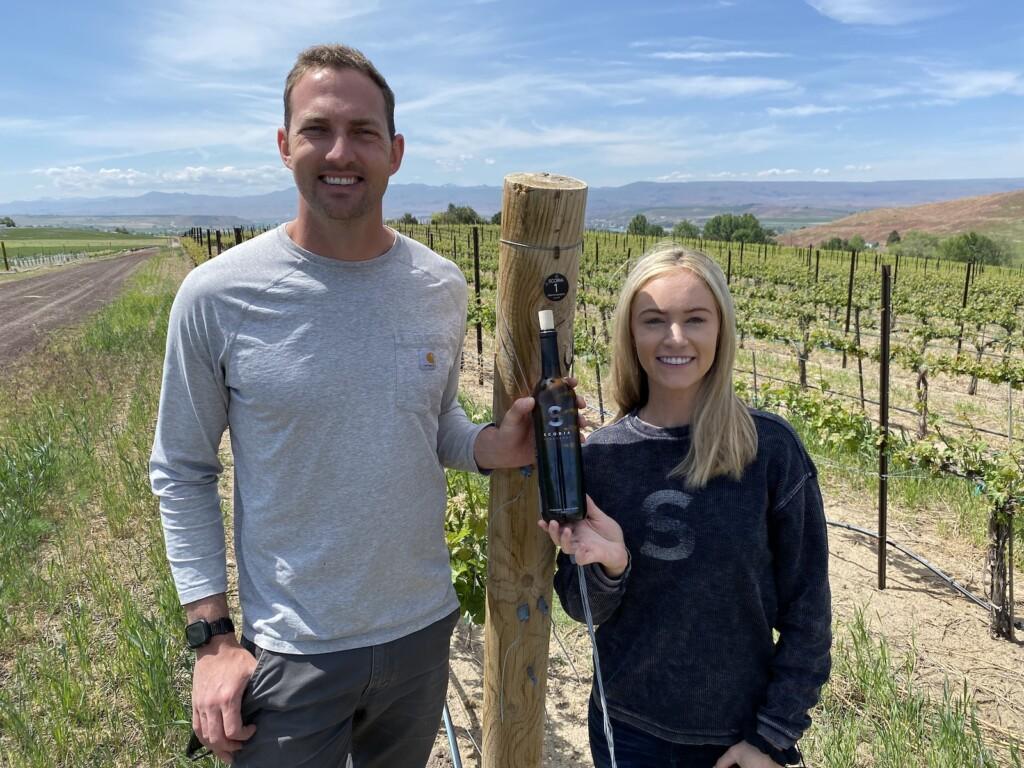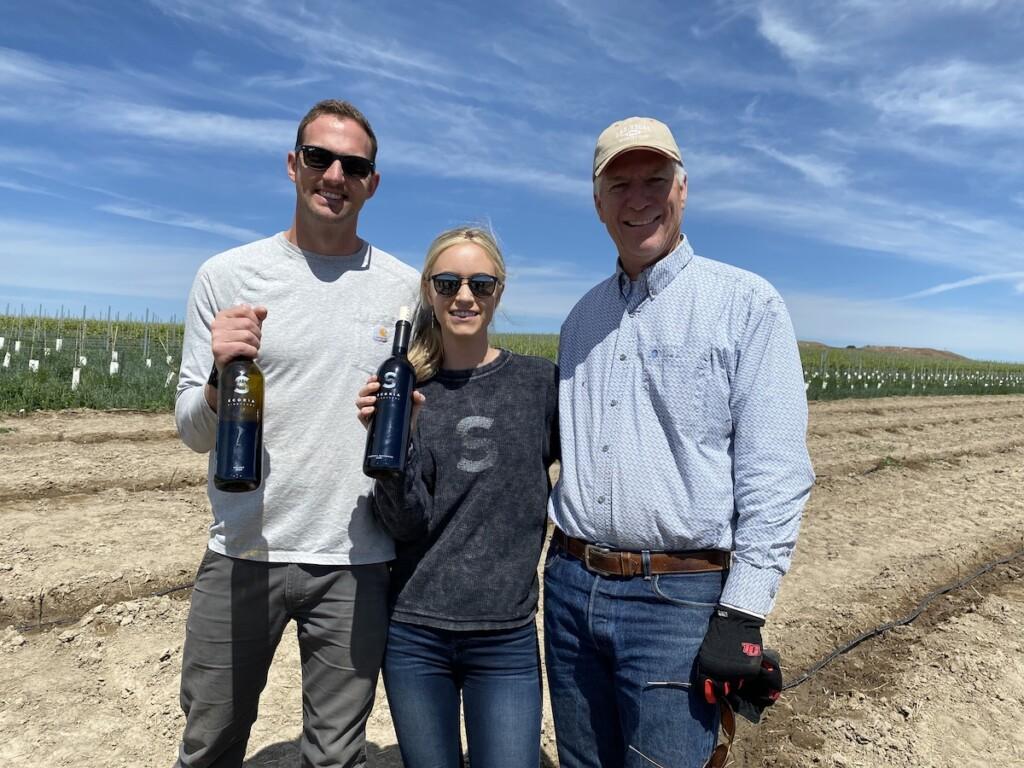
CALDWELL, Idaho — There’s a rich tradition of exquisite dessert wines made with Williamson Vineyard Riesling at Koenig Vineyards, but it’s rare to see a multiple vintage expression of ice wine produced anywhere in the world, much less the Snake River Valley.
This spring, the Koenig Vineyards nonvintage Riesling Ice Wine ($30) merited top awards at two Pacific Northwest judgings — a gold medal at the Cascadia International Wine Competition in Washington’s Columbia Valley and best of show at the Idaho Wine & Cider Competition.
While the theme of that wine belongs to the 2021 season and winemaker James Nederend, there are several chapters involved, including founding winemaker Greg Koenig.
“That year, our block from the Williamsons was slightly short, so we ended up sourcing some Riesling from Roghani Vineyards, which is the first time we’ve ever sourced Riesling for ice wine from there,” Nederend said.
There also is a delicious pedigree of high-scoring late-harvest bottlings from Susan Roghani’s vines. Her 2014 Late Harvest Riesling won a gold medal at the 2020 Idaho Wine Competition. A year later, her 2015 Late Harvest Riesling went double gold and was the Best Sweet Wine.
However, the Williamson block for Koenig ice wine is managed for picking under frigid conditions rather than for a late-harvest style.
“Those older vines up there at Roghani tend to produce fruit that’s a little more acidic with a little less color,” Nederend said. “The Riesling from the Williamsons is always a bit richer, and after that fermentation for the 2021, the blend was a little lighter bodied.”
In order to replicate the traditional profile of Koenig Vineyards Riesling ice wine, they went into the cellar for Hungarian oak barrels of 2014 Riesling ice wine that the Nederends acquired when they purchased the winery from Greg Koenig.
“Greg originally wanted to copy the Hungarian Tokajis, so he gave that a shot and made a lot of it,” Nederend says. “He used 100% brand new Hungarian oak, and it had been in barrel for seven years. We only used two barrels of it.”
The Nederends and the Koenigs stay in contact, so Greg sat in on the blending trials for the ice wine from the 2021 vintage. Those two barrels accounted for 7% of the final production of 600 cases. That’s 2% more than is allowed for a vintage bottling. The U.S. Department of the Treasury’s Alcohol and Tobacco Tax and Trade Bureau (TTB) requires that a finished wine be labeled as “nonvintage” if less than 95% of the grapes were harvested in the same calendar year.
“But with that blending, the ice wine came out just the way it should,” Nederend says. “It added just enough texture and richness.”
The 2014 vintage also marked the last time Koenig spotted and managed botrytis in Riesling blocks at Williamson. Twice, he encouraged the development of those conditions, which led to the second and final bottling of a late-harvest Riesling made in the style of a German trockenbeerenauslese. In 2016, the Koenig Vineyards 2014 Botrytis Single Berry Select Riesling was best of show in Idaho.
“We have the 2012 Hungarian oaked ice wine in bottle, and it’s our highest-end reserve wine, which we sell for $80,” Nederend said.
That’s in the ballpark for many other true ice wines made in North America. The harvest of icewine in Canada must be verified by government officials to have taken place at or below -8 Celsius, which is 17 degrees Fahrenheit. One of the icewine bottlings by famed producer Gehringer Brothers in British Columbia’s Okanagan Valley is branded Minus 9 Icewine.
“The pickers are out there at 8 in the morning when it’s 13 degrees (Fahrenheit),” Nederend says. “Then, we’re shoveling the grapes into a press, and they are pressed for 24 hours — until the next morning.
“Whatever juice we get that next morning is the juice we get that year,” Nederend adds. “Some years, we’ll make 50 cases. Some years, we’ll make closer to 500 cases — all off the same rows.”
It started with SCORIA Vineyards

James Nederend met Sydney Weitz during high school. Each grew up in a Snake River Valley farming family, and they both graduated with business degrees from Boise State University. James was ready to move on from the dairy industry, and Sydney’s passion was in design and marketing.
Before long, Sydney convinced her father, Joe, to enter the wine industry and plant vines near the extinct volcanic vent on a family parcel that was prime for wine grapes but not suited for mint. The site is not far from the Sunnyslope, with Ste. Chapelle just over the rise and Lizard Butte and the Snake River very much in view. Soon, Sydney was working in the tasting room at Koenig Vineyards and mapping out the future of SCORIA Vineyards and Winery.
“I was there for the first harvest off SCORIA in 2016,” Nederend says.
Three years later, out of the blue, Greg and Kristen Koenig approached the Nederends with an offer to sell their brand, the winery and 10 surrounding acres of vines. Part of the deal was for Greg to stay on for a year to mentor James. This fall will mark Nederend’s fifth crush as an Idaho winemaker.
“One of the things that’s pretty cool about Idaho is that our Syrah is grown 200 feet from where I get the Riesling for my ice wine,” Nederend says. “The diversity is amazing. We can do own-rooted vines. And because of the climate, we don’t have to spray as often, so we’re using less pesticides.”
This spring, he, Sydney, Joe and the Weitz farm crew planted 10 more acres at SCORIA — Cabernet Sauvignon, Malbec and Petit Verdot — giving them 36 acres across a site that’s the envy of any Idaho winemaker. There are plans for a scenic tasting room on the estate, which will likely be built before more vines are planted.
“We’re starting to feel like a real vineyard. We might need a vineyard manager,” James chuckled.
And with the guidance of Greg Koenig and Martin Fujishin along the way, Nederend is very much a real winemaker — not only for Koenig and SCORIA, but also the Williamsons and others. The Williamson Vineyards 2020 Sangiovese made in Koenig Vineyards cellar was the Best Red Wine at the 2023 Idaho Wine Competition, edged out by the aforementioned ice wine.
“Last year, we bottled 120 different wines,” Nederend said. “We’re making five or six styles of Riesling. For Cabernet, we have eight vineyard sources for wineries we partner with.
“It’s been a great place to learn winemaking because we’re doing so many wines. We try our best with every single wine, and I think it shows in the competitions. I haven’t needed 10 vintages to learn how to tweak my Riesling.”
Koenig, SCORIA distinctly different

The Nederends and their general manager, Tara Evans, operate three tasting galleries — the showpiece at Koenig Vineyards that Greg Koenig built by hand, the original by-appointment location at SCORIA Vineyards and SCORIA’s stylish spot in downtown Boise.
There is no crossover between the brands. To taste and experience this year’s best-of-show ice wine requires a trip to the Sunnyslope and Hoskins Road.
Four years ago, the Koenig Vineyards 2018 Riesling Ice Wine cruised to the top of the 2019 Idaho Wine Competition. New Orleans broadcaster/writer Tim McNally, a member of that panel, summed up the inherent advantage such world-class ambrosia has on the rest of the field during the sweepstakes portion of any wine judging.
“Is there ever going to be a competition where a great ice wine doesn’t win everything?” McNally declared. “When you taste it, what goes through my mind is ‘Why doesn’t EVERYONE like wine? What is there not to like about this beautiful nectar?’ ”
With a smile, Nederend points out, “The ice wine has paid a lot of bills here for a long time. For a while, it was Greg’s best-selling wine.”
